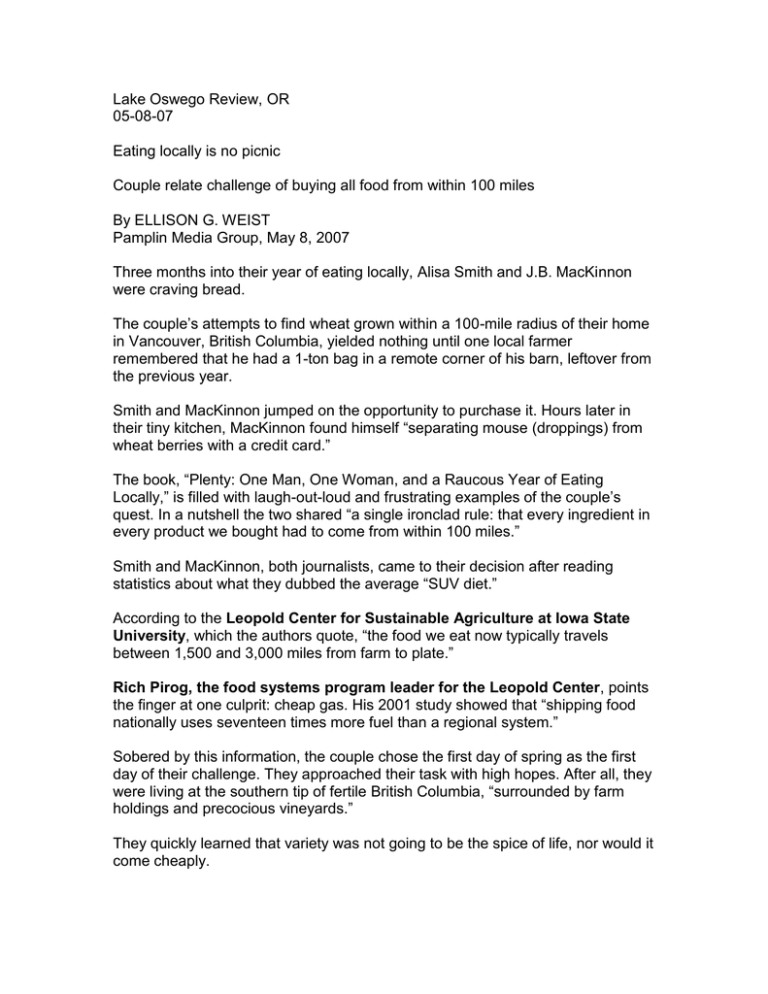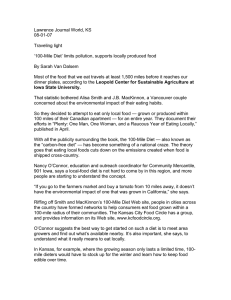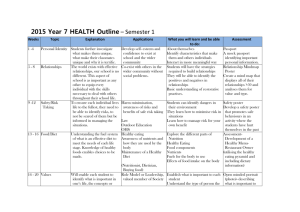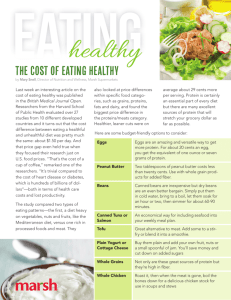Lake Oswego Review, OR 05-08-07 Eating locally is no picnic
advertisement

Lake Oswego Review, OR 05-08-07 Eating locally is no picnic Couple relate challenge of buying all food from within 100 miles By ELLISON G. WEIST Pamplin Media Group, May 8, 2007 Three months into their year of eating locally, Alisa Smith and J.B. MacKinnon were craving bread. The couple’s attempts to find wheat grown within a 100-mile radius of their home in Vancouver, British Columbia, yielded nothing until one local farmer remembered that he had a 1-ton bag in a remote corner of his barn, leftover from the previous year. Smith and MacKinnon jumped on the opportunity to purchase it. Hours later in their tiny kitchen, MacKinnon found himself “separating mouse (droppings) from wheat berries with a credit card.” The book, “Plenty: One Man, One Woman, and a Raucous Year of Eating Locally,” is filled with laugh-out-loud and frustrating examples of the couple’s quest. In a nutshell the two shared “a single ironclad rule: that every ingredient in every product we bought had to come from within 100 miles.” Smith and MacKinnon, both journalists, came to their decision after reading statistics about what they dubbed the average “SUV diet.” According to the Leopold Center for Sustainable Agriculture at Iowa State University, which the authors quote, “the food we eat now typically travels between 1,500 and 3,000 miles from farm to plate.” Rich Pirog, the food systems program leader for the Leopold Center, points the finger at one culprit: cheap gas. His 2001 study showed that “shipping food nationally uses seventeen times more fuel than a regional system.” Sobered by this information, the couple chose the first day of spring as the first day of their challenge. They approached their task with high hopes. After all, they were living at the southern tip of fertile British Columbia, “surrounded by farm holdings and precocious vineyards.” They quickly learned that variety was not going to be the spice of life, nor would it come cheaply. After six weeks of eating potatoes up to three times a day, Smith found herself craving green. In May she returned home from a trip to Vancouver Island with a bag of spring mesclun. Cost? $17.99 a pound. Relief came with the advent of farmers markets in the spring. But as summer fades, the authors detail a variety of challenges that will surprise many readers. Who knew that corn needs to be blanched and frozen within hours of when it’s picked? As Smith notes, “Putting away food for winter was like adding a part-time job to our full-time lives.” Plus there was the question of finding protein for two people who had been vegetarians most of their adult lives. In the past they had enjoyed beans, lentils and tofu. Quickly they learned that their normal diet had “depended on a longdistance food system heavy with environmental costs.” Smith and MacKinnon divide their book into 12 chapters, for each month of their year of eating locally. They take turns writing about their exploits and kick off each essay with a “100-Mile Diet” recipe. Both writers have their own style – MacKinnon’s entries read like a novel while Smith is more comfortable with the chatty essay form – but the result is cohesive and interesting. The authors get their point across in an engaging, often hilarious fashion. By the end of their year of following the 100-Mile Diet the couple has a renewed respect for small farmers and the local food movement. They side with advocates such as author Marion Nestle, former chairwoman of nutrition, food studies and public health at New York University, who says, “We have an insane food system, one that’s totally based on cheap oil.” The 100-Mile Diet may not be for everyone. But “Plenty” will appeal to consumers who value sustainability and honor local food sources. And who don’t mind separating the chaff from the mouse droppings. ellisonweist@portlandtribune.com








